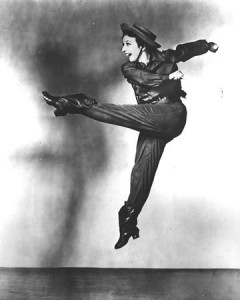70th Anniversary – Pops go to the Rodeo!

1942 Agnes de Mille, Rodeo, American subject matter in ballet
Today marks the 70th anniversary of the symphonic premier of Aaron Copland’s Four Dance Episodes from Rodeo. Originally written as a ballet in five sections, Rodeo was pared down to a four movement symphonic work which was premiered by the Boston Pops Orchestra under the direction of Arthur Fiedler.
Aaron Copland (1900 – 1990) was an American composer, composition teacher and conductor. He is one of the pioneers of the “American style” of composition, and was often referred to as the “Dean of American Composers.” The son of Russian immigrants, Copland was born in Brooklyn, NY, in 1900, and began writing music in his teens. Eventually, Copland traveled to France to study composition at the Fontainebleau School of Music under Nadia Boulanger, who also taught Philip Glass, Astor Piazolla and Quincy Jones. Copland is best known for his orchestral music, including Billy the Kid, Appalachian Spring and the Fanfare for the Common Man.
The ballet version of Rodeo was choreographed by the Ballet Russe de Monte Carlo. The Ballet Russe de Monte Carlo was formed in 1938 by members of the original Ballet Russe. One of the founding members of the Ballet Russe de Monte Carlo, Rene Blum, was one of the first Jews to be arrested during the German occupation of France. In September 1942, just one month before the premier of the ballet Rodeo, he was sent to the Auschwitz concentration camp where he was later killed.
The original version of Rodeo consisted of five dance scenes: “Buckaroo Holiday,” “Ranch House Party,” “Corral Nocturne” (partially composed by Leonard Bernstein), “Saturday Night Waltz” and “Hoe-Down.” For the symphonic version of Rodeo, Copland omitted the “Ranch House Party,” but left the remaining four movements intact.
Rodeo, like many of Copland’s other works, incorporates traditional American folk tunes (such as the use of the Shaker hymn “Simple Gifts” for his Appalachian Spring). Some of the tunes include “Old Paint,” “Bonaparte’s Retreat” and “McLeod’s Reel.” Copland’s treatment of “Bonaparte’s Retreat” (in the “Hoe-Down” movement) has become one of the most famous moments of Rodeo, in part because of its use as the background music for a series of commercials by the American Beef Council. In fact, most people immediately recognize the end of “Hoe-Down” by imagining the voices of Robert Mitchum and Sam Elliot interrupting the music by saying “Beef, it’s what’s for dinner.”
Dr. Scott M. Kiser is a classical trumpet player who served 5 years in the US Navy, primarily with Navy Band New Orleans. During that time, Dr. Kiser was a regular performer at Museum events!
- Posted :
- Post Category :
- Tags : Tags: Auschwitz, Music in WWII
- Follow responses to this entry through the RSS 2.0 feed. You can skip to the end and leave a response. Pinging is currently not allowed.




Leave a Reply